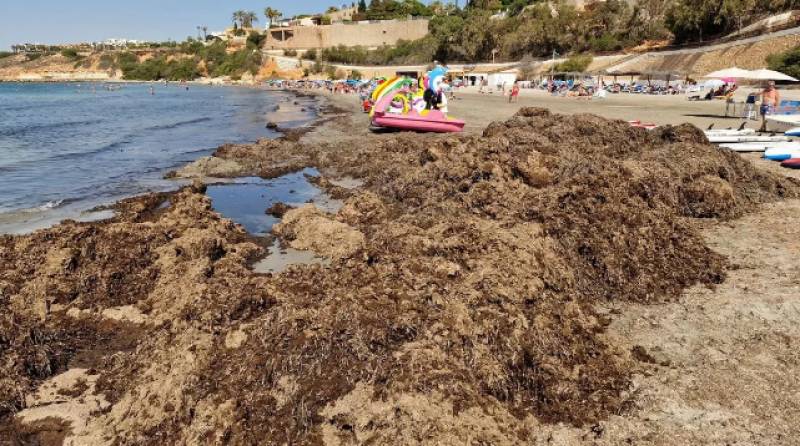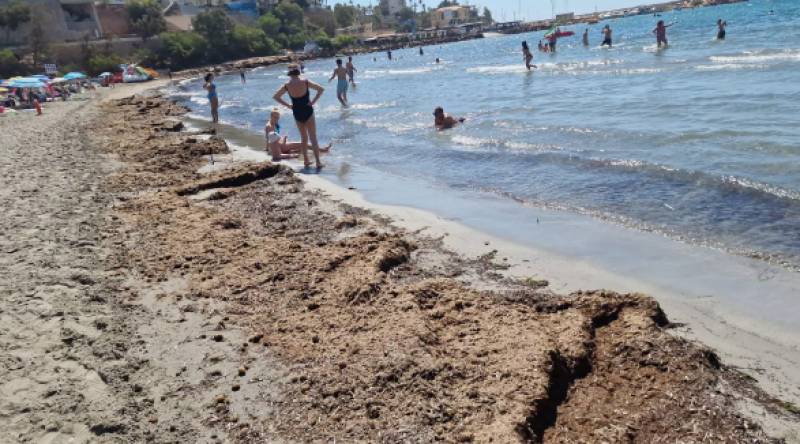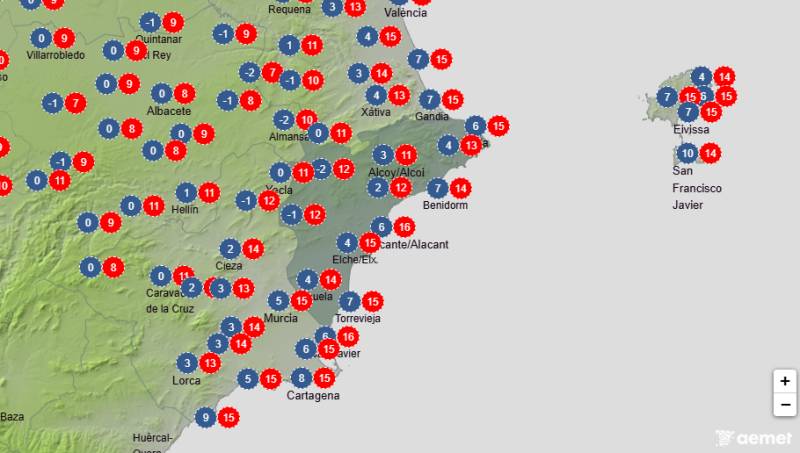- Region
- Vega baja
- Marina Alta
- Marina Baixa
- Alicante
- Baix Vinalopo
- Alto & Mitja Vinalopo
-
ALL TOWNS
- ALICANTE TOWNS
- Albatera
- Alfaz Del Pi
- Alicante City
- Alcoy
- Almoradi
- Benitatxell
- Bigastro
- Benferri
- Benidorm
- Calosa de Segura
- Calpe
- Catral
- Costa Blanca
- Cox
- Daya Vieja
- Denia
- Elche
- Elda
- Granja de Rocamora
- Guardamar del Segura
- Jacarilla
- Los Montesinos
- Orihuela
- Pedreguer
- Pilar de Horadada
- Playa Flamenca
- Quesada
- Rafal
- Redovan
- Rojales
- San Isidro
- Torrevieja
- Comunidad Valenciana
article_detail
Date Published: 03/07/2024
Orihuela Costa beaches clogged with smelly seaweed
Orihuela City Council is waiting for permission to remove the unsightly algae

La Caleta beach in Cabo Roig
Sun, sand and... smelly seaweed? That’s the unexpected situation beachgoers on the Orihuela Costa have been facing this season, just weeks after the shores have finally reopened all of their beach bars and other facilities. Tonnes of algae have washed up along the coastline, even on the busiest beaches like Cabo Roig, leading to complaints from disappointed swimmers and sunbathers.
The culprit behind these unwelcome piles of greenery is primarily posidonia, with some seagrass (Cymodocea nodosa) mixed in. Storms and swells in the area have contributed to these organic materials washing up on shore.
While the Costa Blanca in general often experiences accumulations of seaweed remains, or “banks”, the sheer volume this year has caught many off guard.
“It is very annoying and creates bad smells,” said one holidaymaker on the beach in La Caleta.

In response to the complaints, the Orihuela City Council has reminded residents and visitors that there are specific periods designated by Valencian law for the removal of these organic materials. According to a decree issued in May 2022, the collection of seaweed remains from the beaches is permitted between March 15 and October 31 for urban and natural beaches, and from May 1 to September 30 in exceptional cases.
Municipal sources explain that the Orihuela Costa’s eleven beaches undergo drying processes starting in May, with collection typically commencing in July. The City Council is currently awaiting permission from the Department of the Environment to remove the seaweed, assuring residents that “the removal is imminent”.
While the accumulation of seaweed may be an eyesore and a source of unpleasant odours, it is important to recognise its positive impact on the stability of the beaches. Acting as a natural barrier against marine erosion, which is a big problem on the Orihuela Costa, the decomposition of these organic materials helps prevent excessive sand loss.

“It’s a plant, not rubbish,” the Department of Street Cleaning reminded beachgoers via social media, a vital organism in preventing the complete erosion of the beaches.
“On all our beaches there is a seaweed drying area, but they are not abandoned and they are not rubbish; all the waste - paper, cans, plastics, bottles...- that beach users throw on them is rubbish,” the spokesperson concluded.
In any case, as the summer season continues, beachgoers can expect the removal of seaweed remains to commence soon, restoring the beaches to their pristine condition.
Images: AVCRL
staff.inc.ali
Loading
Sign up for the Spanish News Today Editors Roundup Weekly Bulletin and get an email with all the week’s news straight to your inbox
Special offer: Subscribe now for 25% off (36.95 euros for 48 Bulletins)
OR
you can sign up to our FREE weekly roundup!
Read some of our recent bulletins:
Discount Special Offer subscription:
36.95€ for 48 Editor’s Weekly News Roundup bulletins!
Please CLICK THE BUTTON to subscribe.
(List price 3 months 12 Bulletins)
Read more stories from around Spain:
Contact Murcia Today: Editorial 000 000 000 /
Office 000 000 000





































